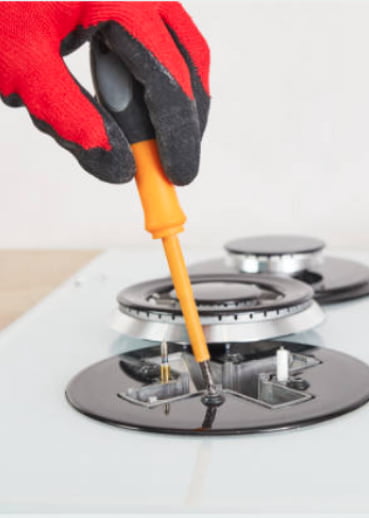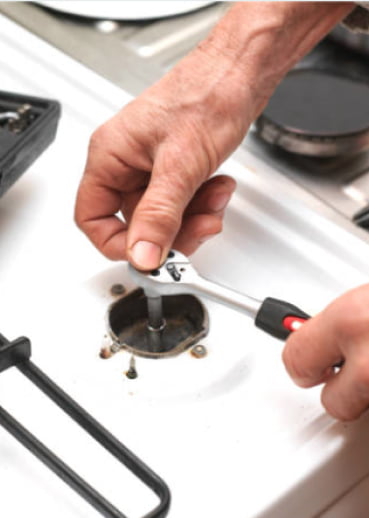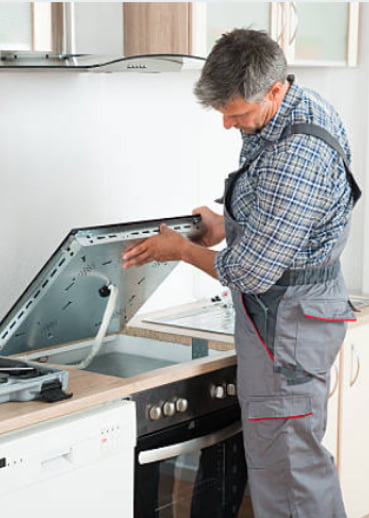Are there any questions left?
Contact us and we will answer!
COMMON RANGE PROBLEMS AND HOW TO FIX THEM: A GUIDE BY FASTAID
A malfunctioning range can disrupt your cooking routine and pose safety risks in your kitchen. FastAid Appliance Repair understands the importance of a properly functioning range, and we are committed to providing reliable solutions for common range problems. With our team of experienced technicians in Charlotte, NC, you can trust us to diagnose and resolve various range issues efficiently and effectively.
In this comprehensive guide, we aim to empower homeowners in Charlotte and surrounding areas with the knowledge and tools to troubleshoot and fix common range problems on their own. We understand that not every issue requires professional intervention, and that's why we provide step-by-step troubleshooting and repair tips. Whether you're dealing with a gas burner not igniting, an electric element not heating, uneven cooking temperatures, faulty control knobs, oven not heating, or other range repairs, our guide has you covered.
By following the guidance in this guide, you can save time and money by addressing range problems yourself whenever possible. However, for more complex or challenging issues, the FastAid Appliance Repair team is always ready to assist you. We have the expertise and experience to handle any range repair, ensuring that your appliance operates optimally and safely.
Common Range Problems
Don't let common range problems hinder your culinary creations. With FastAid Appliance Repair and this comprehensive guide, you can regain control over your cooking experience and keep your kitchen running smoothly. Let's explore the world of range troubleshooting and repairs, empowering you to become a savvy homeowner when it comes to maintaining your appliance.

Range Gas Burner Not Igniting
One common range problem is a gas burner that refuses to ignite, leaving you unable to cook your favorite meals. We'll delve into potential causes, such as clogged burner ports, faulty igniters, or issues with the gas supply. Our guide will offer step-by-step instructions on how to troubleshoot and fix these issues, ensuring your gas range ignites reliably.

- Check Gas Supply: Ensure that the gas supply to the range is turned on and that the gas valve is fully open. If you suspect a gas supply issue, consult a professional technician or your gas utility company.
- Clean Burner Ports: Remove the burner grates and caps, and use a small pin or needle to clear any debris or residue from the burner ports. Blocked ports can hinder gas flow and ignition.
- Inspect Igniter: Look for visible damage or signs of wear on the igniter. If the igniter is faulty, it may need to be replaced. Consult your range's manual for guidance or contact a professional technician.
- Check Igniter Spark: Turn off the room lights, turn on the range, and observe the igniter spark when you attempt to ignite the burner. If there is no spark or a weak spark, the igniter may require adjustment or replacement.
- Clean and Dry Components: Ensure all cleaned components are thoroughly dry before reassembling the burner caps and grates.
Range Electric Element Not Heating
If your electric range's elements are not heating, it can hinder your cooking efforts. We'll explore potential causes, such as a faulty surface element, a damaged receptacle block, or issues with the control switch. Our guide will provide troubleshooting steps to help you identify the problem and restore proper heating to your electric range.

- Check Power Supply: Verify that the range is receiving power by checking the circuit breaker or fuse box. Reset a tripped breaker or replace a blown fuse of the same amperage if necessary.
- Inspect the Surface Element: Look for visible damage, such as blistering or visible breaks, on the surface element. A damaged element may need to be replaced with a compatible replacement.
- Examine the Receptacle Block: Inspect the receptacle block where the surface element connects. If it shows signs of burning or damage, it may need to be replaced. Consult your range's manual or contact a professional technician for guidance.
- Test the Control Switch: Use a multimeter to test the control switch for continuity. If the switch is faulty, it may need to be replaced.
- Seek Professional Help: If you're unsure about performing electrical tests or replacing components, it's best to seek assistance from a professional technician to avoid safety risks.

Range Uneven Cooking Temperatures
Cooking with uneven temperatures on your range can result in poorly cooked meals. We'll explore potential causes, such as a faulty temperature sensor, improper cookware, or issues with the range's heating elements. Our guide will offer tips on how to troubleshoot and address these issues for consistent cooking results.
- Use Cookware with Flat Bottoms: Ensure that your cookware has flat and even bottoms to ensure proper contact with the range's heating elements.
- Inspect the Temperature Sensor: A faulty temperature sensor can lead to uneven cooking temperatures. Consult your range's manual or contact a professional technician to test and replace the sensor if necessary.
- Calibrate Range Settings: Some range models allow you to adjust temperature settings. Refer to your range's manual for instructions on calibration.
- Keep Range Clean: Regularly clean the range to prevent debris or spills from affecting the heating elements' performance.
- Seek Professional Assistance: If the issue persists or you suspect internal problems with the range, it's best to seek help from a professional technician to accurately diagnose and fix the problem.

Range Faulty Control Knobs
Control knobs that are difficult to turn or don't function properly can be frustrating. We'll explore potential causes, such as worn-out knobs, faulty control switches, or damage to the knob's shaft. Our guide will provide tips on how to troubleshoot and address these issues to regain control over your range settings.
- Inspect the Control Knobs: Check for visible damage or wear on the control knobs. Worn-out knobs may need to be replaced with compatible replacements.
- Test Control Switches: Use a multimeter to test the control switches for continuity. If the switches are faulty, they may need to be replaced.
- Examine the Knob's Shaft: Look for damage or signs of wear on the knob's shaft that could be preventing it from turning properly. A damaged shaft may require replacement.
- Apply Lubrication: If the knobs are difficult to turn, apply a small amount of silicone-based lubricant to the shaft to facilitate smoother rotation.
- Seek Professional Help: If you're uncertain about performing electrical tests or replacing components, it's best to seek assistance from a professional technician to avoid safety risks.

Oven Not Heating
A range with an oven that fails to heat can be a significant inconvenience. We'll explore possible causes, such as a faulty bake element, a malfunctioning oven sensor, or a broken heating element. Our guide will provide troubleshooting steps to help you identify and address the problem, ensuring your oven heats properly for all your culinary creations.
- Check the Power Supply: Ensure the range is receiving power by checking the circuit breaker or fuse box. Reset a tripped breaker or replace a blown fuse of the same amperage if necessary.
- Inspect the Bake Element: Look for visible signs of damage or burning on the bake element. If the element is defective, it may need to be replaced with a compatible replacement.
- Test the Oven Sensor: Use a multimeter to test the oven sensor for continuity. If the sensor is faulty, it may need to be replaced.
- Examine the Heating Element: If your range has a separate broil element, inspect it for visible damage or burning. A broken broil element may require replacement.
- Seek Professional Help: If you're unsure about performing electrical tests or replacing components, it's best to seek assistance from a professional technician to avoid safety risks.

Other Range Repairs
In this section, we'll cover additional range repairs, such as malfunctioning oven lights, control panel issues, broken knobs, faulty timers, or self-cleaning problems. Our expert technicians have the knowledge and expertise to diagnose and fix various range components, ensuring your appliance operates optimally and safely.
- Oven Light Replacement: If the oven light is not working, start by replacing the light bulb. Ensure that the range is unplugged or the power is off before replacing the bulb.
- Control Panel Issues: Problems with the range's control panel, such as unresponsive buttons or error codes, may indicate a control board malfunction. Consult your range's manual or contact a professional technician to diagnose and address the issue.
- Broken Knobs: If the knobs are damaged or have become loose, they may need to be replaced to ensure smooth operation.
- Faulty Timers: If the range's timers are not functioning correctly, they may need to be recalibrated or replaced. Refer to your range's manual for instructions on timer adjustments.
- Self-Cleaning Problems: If your range has a self-cleaning feature that's not working properly, it may require troubleshooting or professional service to address the issue.
Professional Range Repair in Charlotte, NC
By following the troubleshooting tips and repair techniques provided in this guide, homeowners in Charlotte and surrounding areas can address common range problems and keep their kitchens running smoothly. FastAid Appliance Repair is committed to providing expert range repair services, offering fast and reliable solutions to ensure your range operates optimally and safely.
For professional assistance with range repairs in Charlotte, NC, contact FastAid Appliance Repair today. Our skilled appliance repair technicians are ready to diagnose and resolve any range issue you may encounter. Trust us to keep your range in excellent working condition.
Range Problems FAQs
A malfunctioning bake element or oven sensor could be the cause of your electric oven not heating properly. Inspect the bake element for visible damage and test the oven sensor with a multimeter for continuity. Replace any faulty components as needed, or seek professional assistance for accurate diagnosis and repair.
Gas burner ignition problems may result from clogged burner ports or a faulty igniter. Clean the burner ports with a pin or needle to clear any debris, and inspect the igniter for visible damage. If the issue persists, consult your range's manual or contact a professional technician for assistance.
Yes, replacing control knobs is typically a simple task that many homeowners can do themselves. Make sure to get the correct replacement knobs for your range model, and follow the manufacturer's instructions for installation.
Yes, you can replace the oven light bulb yourself. Ensure that the range is unplugged or the power is off before replacing the bulb. Refer to your range's manual for specific instructions on how to access and replace the light bulb. If you encounter any difficulties, seek assistance from a professional technician.